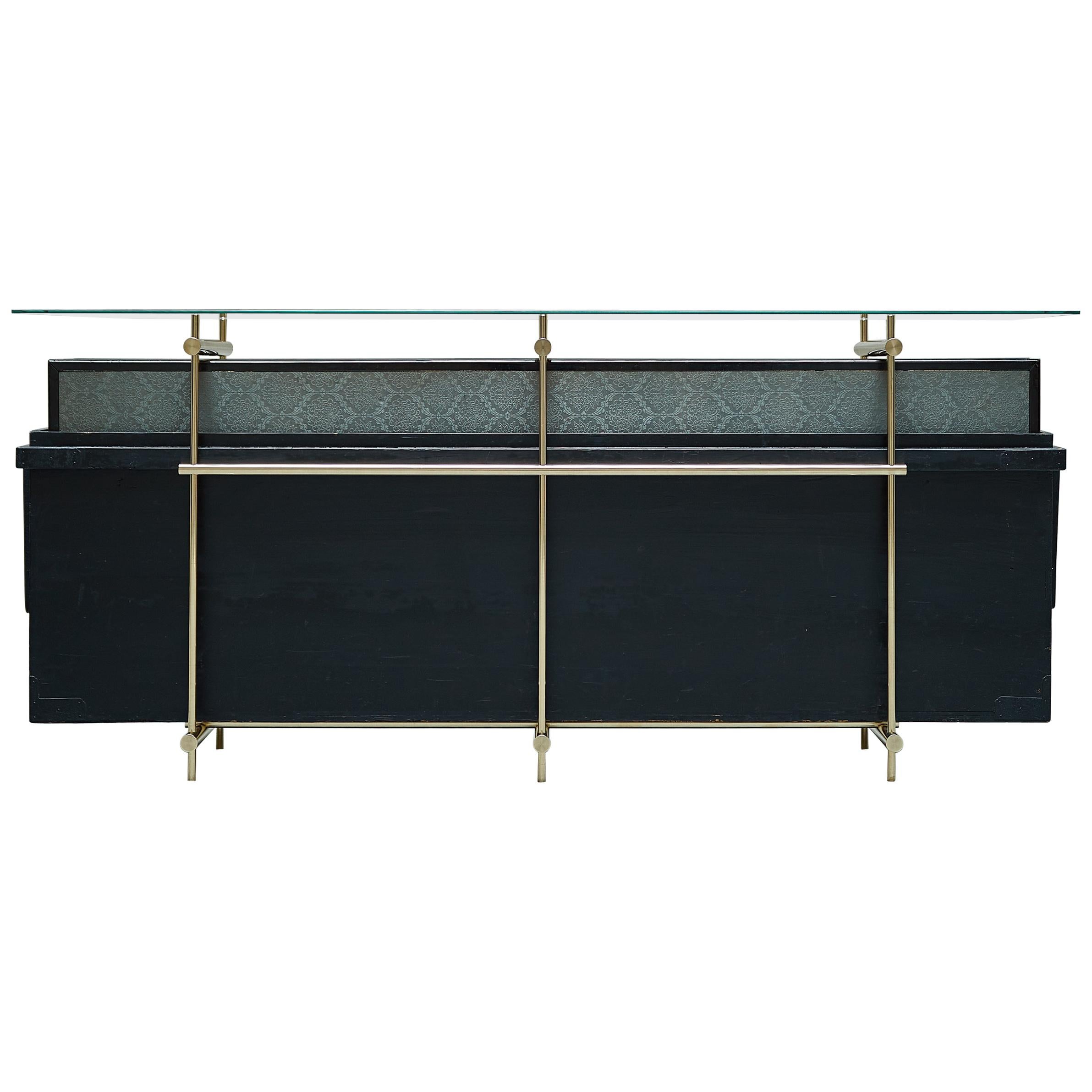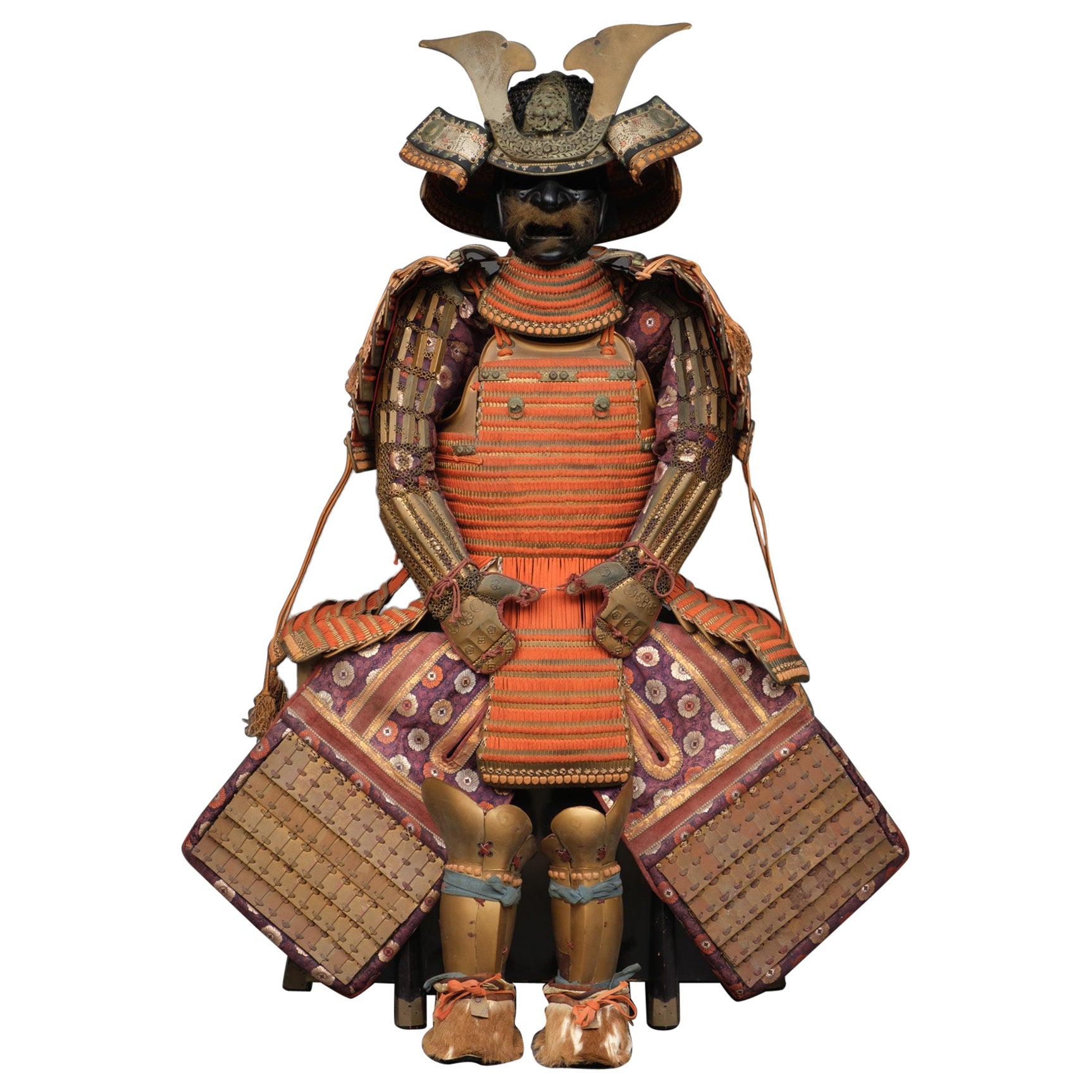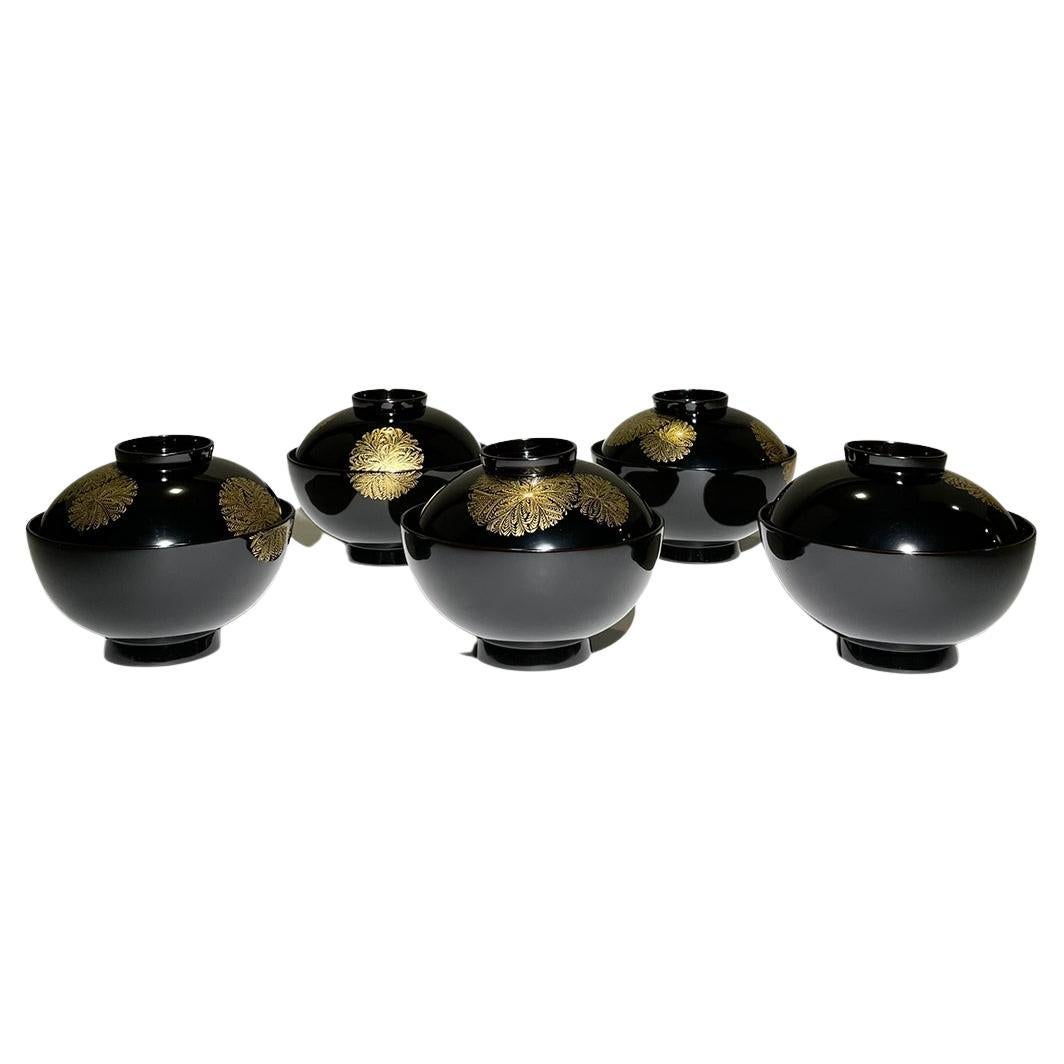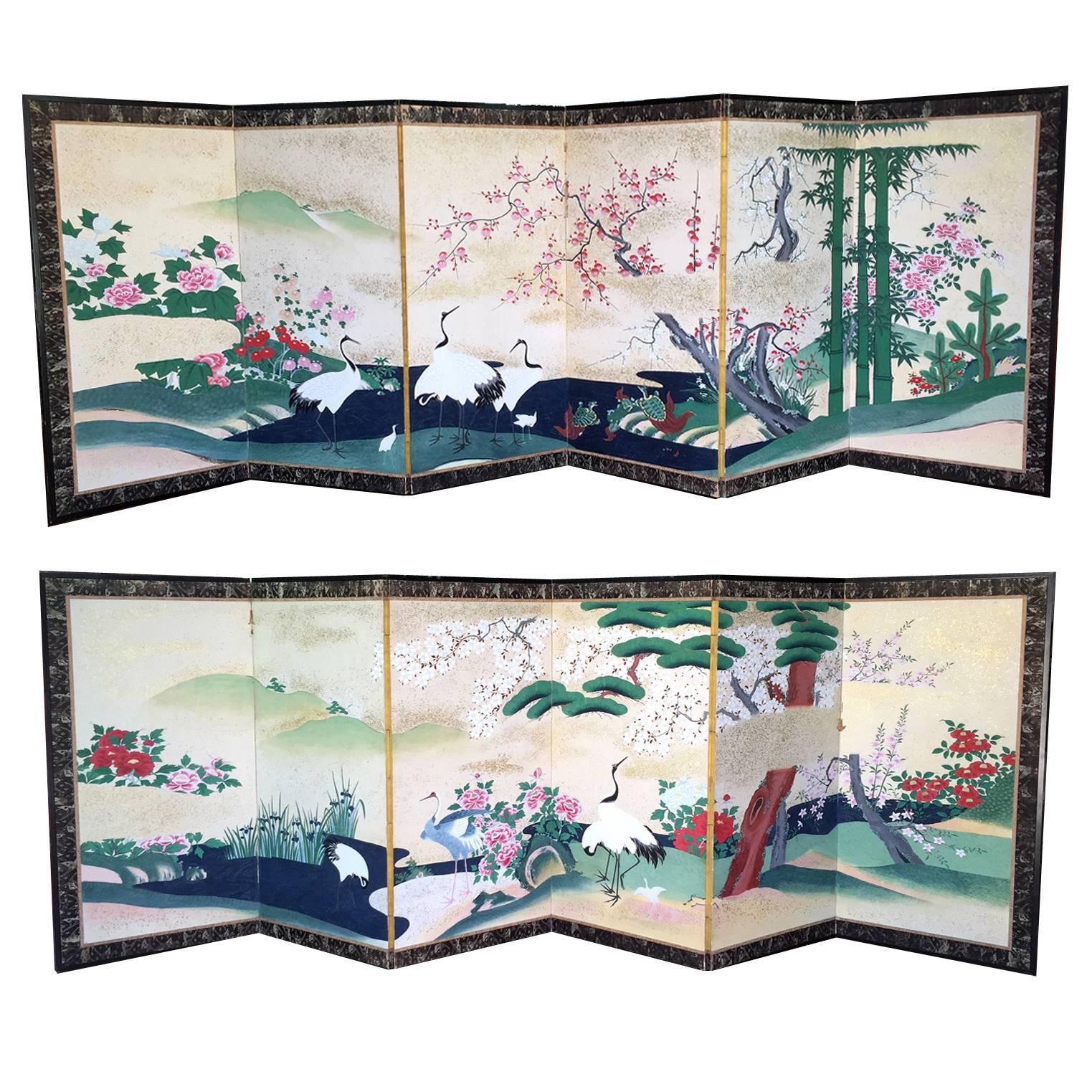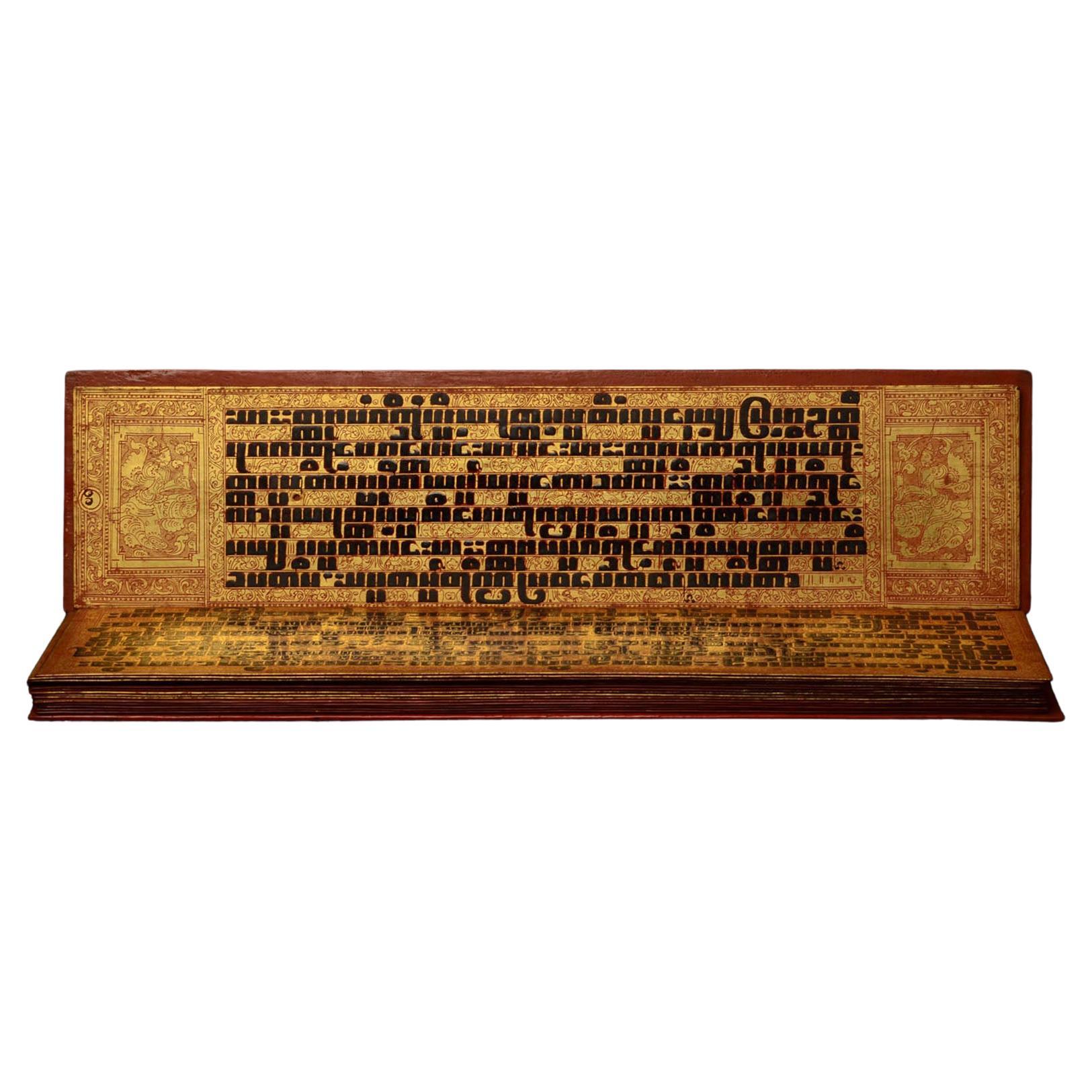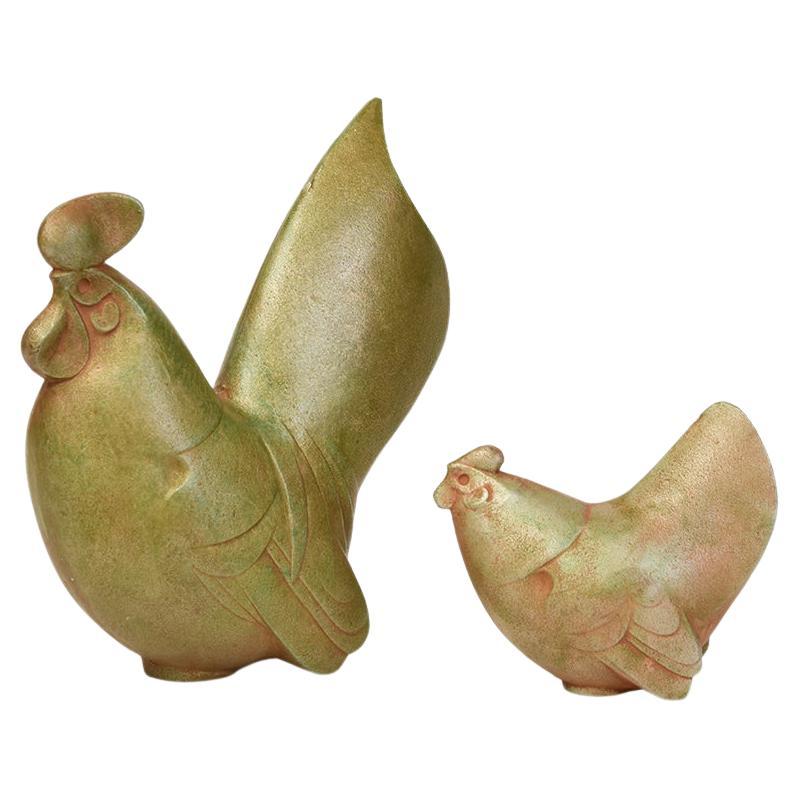Items Similar to Rare set of 2 Japanese suits-of-armour, complete with 2 matching folding screens
Want more images or videos?
Request additional images or videos from the seller
1 of 21
Rare set of 2 Japanese suits-of-armour, complete with 2 matching folding screens
About the Item
Important unique set of two suits-of-armour (yoroi), complete with two high six-panel screens, that belong together as is indicated by the used family crests (mon). Two crests are used, both belonging to the Nakagawa family of Oka Castle, Ôita prefecture on Kyûshû.
They are:
– the Nakagawa-kurusu, a circle depicting a Celtic-like cross through a ring.
The cross was originally a Christian symbol but after the ban on Christianity in Japan the use of a hidden cross in family crests could continue.
– the Nakagawa-kashiwa, two leaves of the Japanese Emperor Oak turned to each other (dakikashiwa mon).
The remarkable aspect of this ensemble is the presence of matching crests on both the yoroi and the accompanying folding screens. The kurusu and kashiwa crests adorning the yoroi are elegantly replicated on the screens, providing compelling evidence that these pieces form a harmonious and unified set. This exceptional cohesion between the armour and screens further enhances their artistic and historical value.
After the warlord Toyotomi Hideyoshi (1537-1598) had interfered in the battle between the Lord of Bungo Province Ôtomo Yoshi-mune (1558-1605) and the Shimazu of Hyûga Province, he split the Bungo Province in a number of small fiefs and transferred in 1594 Nakagawa Hideshige (1570-1612) from Miki Castle
in the Harima Fief to Oka Castle in Kyûshû.
The Nakagawa family stayed in possession of Oka Castle till the abolishment of the military use of castles in 1873. In 1884 the Nakagawa family received the title of Count (a title in use till the abolishment of aristocracy in 1947).
After the Nakagawa’s left, the castle and the building soon dilapidated and is now known as Oka Castle Ruins. The castle is located in Taketa Village part of Taketa Town in Ôita Province on Kyûshû.
> Set of two tall byôbu (folding screens),
painted with large red jinmaku (camp enclosure curtain) on a gold leaf ground. The curtains show both crests of the Nakagawa family: one screen depicts two Nakagawa-kurusu crests next to a Nakagawa-kashi crest in the middle, and the other shows the symbols the other way round.
Dimensions:
Total width 148.66 in/377.6 cm (2 x 25.35 in/64.4 cm, 4 x 24.48 in/62.2 cm); Height 72.63 in/184.5 cm.
Period: Japan – Late Edo period (First half 19th century), and maybe even older.
> Yoroi with Nakagawa-kashiwa crest:
A Japanese black lacquered suit-of-armour (yoroi) completely laced with orange cords (kuro’urushinuri hi’ito odoshi nimai’dô’maru).
A thirty-two plate suji’bachi kabuto (helmet with raised ridges) with in front a maedate (fore crest) -with traces of gilding- in the shape of flames, resembling a mythical flaming bird flying down. The fukikaeshi (face guards) and the mabizashi (visor) have the Nakagawa-kashiwa crest in gold maki-e lacquer.
Five curved ‘itazane’-plate neck guards (shikoro) laced with orange cords.
Together with an ‘angry man’-facial mask (resseibô) with a separate nose piece, brown moustache and a four-piece ‘kiritsuke kozane’-plate gorget (yodarekake).
The arms (kote) are protected by various black lacquered pieces connected by Japanese mail (kaushi-gusari), of which two shaped like bottle gourds, hence this type of sleeve armour is called hisago’kote (bottle gourd bracer). The elbow’s protective plate is in the shape of a chrysanthemum flower, and the hand guards (tekko) with a flower-emblem in relief. Placed over a blue-green-golden brocade silk with a dragon and flower design.
Two-part maru’dô (cuirass) made of a ‘odoshi’-type laced ‘kiritsuke kozane’-plate construction. The front fitted with a cord-ring with a chrysanthemum-shaped backplate. The back equipped with an iron hook (gattari) and leather support for a flag-pole (machi’uke).
From the cuirass hangs a 7-parts of 5-piece ‘kiritsuke kozane’-plate kusazuri (tassets).
The haidate, ‘shino’-type, constructed with black lacquered metal pieces connected by Japanese mail. The ones oth the bottom shaped like a chrysanthemum flower as well. Placed over ensuite brocade silk mounted with golden silk borders with a plum blossom design. It has flaps to tie around the leg.
Brocade silk suneate -that originally had vertical metal strips- protect the lower legs with a very special feature. The leather parts around the inner ankles are decorated with oak leaves that together form the Nakagawa-kashiwa crest.
With a square red lacquered store-box for a suit-of armour (yoroi’bako) with iron ‘pole carrying’-handles.
Period: Japan – Early/Mid Edo Period (17th/18th century).
Height ca. 150 cm.
> Yoroi with Nakagawa-kurusu crest:
A complete Japanese black lacquered suit-of-armour (yoroi) laced with dark blue cords, multi-coloured and orange hems, rare 5-piece yukinoshita-dô and impressive half-moon maedate (kuro’urushinuri kon’ito hi’suso go’mai’yukinoshita’dô tôsei gusoku).
A sixty-two plate suji’bachi kabuto (helmet with raised ridges) with in front a large brass half-moon maedate (fore crest). The fukikaeshi (face guards) fitted with gilded appliques in relief depicting the ‘Nakagawa-kurusu’-crest. Orange decorative tassel (agemaki) at the back. Four curved ‘itazane’-plate neck guards (shikoro) laced with en-suite cords.
Together with an ‘angry man’-facial mask (resseibô) with a separate nose piece, brown moustache and a four-piece ‘itazane’-plate gorget (yodarekake).
Tôsei-type of shoulder guards (sode) constructed with 5 rows of arched ‘itazane’-plates.
Tsubo’kote (bracers) with tube-shaped lacquered plates connected by Japanese mail (kaushi-gusari), placed over blue brocade silk with flower design. The elbows covered by a protective plate shaped like a chrysanthemum flower.
Dô (cuirass) of the rare ‘yukinoshita’-type with ‘apricot’-shaped kohire (winglets) jutting out from the shoulder boards over the points of the shoulder, protecting them. These kohire are fitted with matching appliques depicting the ‘Nakagawa-kurusu’-crest. Equipped with 8(!)-parts of 5-piece ‘itazane’-plate kusazuri (tassets).
Large haidate (thigh armour) of 5-rows of 15 ‘iyo’-plates, over matching silk and decorative ‘smoked leather’ borders with flaps to tie around the leg.
Suneate (shin guards), ‘shino’-type, vertical metal plates connected by Japanese mail placed over brown brocade silk with a crimson tateage (knee guards).
Including a uncommonly tall brown lacquered store-box for a suit-of armour (yoroi’bako) with arched sides. A side equipped with two rings. These where used to make a rig for the samurai’s attendant to carry this box as a back-pack! The wooden plaque with the opening in between was made to make the load a bit more comfortable.
Carved with the character mae 前 (“in front”) in gold. The Kanji “Mae” meaning “the first”; in other words: “I, who has priority above others”.
Period: Japan – Late Edo period (Late 18th/early 19th century).
Height ca. 170 cm.
A marvellous unique set, and highly exceptional that this has stayed together through time in such a condition. Considering their age they are in a very good condition with some restorations and traces of wear conform age.
The screens are in a good restored condition with quality gold leaf restorations in front. and matching paper restoration and some wear on the back
Both suits with traces of wear conform age, like aging of the brocade of the ‘kashiwa’-yoroi. The collar of the ‘kurusu’-yoroi and the knee guards of the ‘kashiwa’-yoroi refurbished of high quality in an original manner. The yoroi’bako of the ‘kurusu’-yoroi restored. Please look at the photos for a clear condition reference.
Provenance: Japan – Bought from an esteemed dealer who has its location situated in close proximity to the Oka Castle ruins, further enhancing the historical origins of this set.
We include a wooden stand and an explanation how to put this armour on display. When shipped we will add a certificate of authenticity.
Due to the delicate nature of the set, custom-made wooden crates will be crafted for its safe transportation, resulting in a slightly extended shipping process time.
Kindly get in touch with us so that we can offer you an appropriate shipping quotation, or if you prefer additional detail photos.
- Dimensions:Height: 72.64 in (184.5 cm)Width: 148.67 in (377.6 cm)Depth: 0.71 in (1.8 cm)
- Sold As:Set of 4
- Materials and Techniques:
- Place of Origin:
- Period:
- Date of Manufacture:Edo period (1600-1868)
- Condition:Repaired. Refinished. Wear consistent with age and use. Minor losses. As described in the description, and please have a close look at the photos.
- Seller Location:Amsterdam, NL
- Reference Number:
About the Seller
5.0
Vetted Seller
These experienced sellers undergo a comprehensive evaluation by our team of in-house experts.
Established in 1996
1stDibs seller since 2022
16 sales on 1stDibs
Typical response time: 10 hours
- ShippingRetrieving quote...Ships From: Zwanenburg, Netherlands
- Return PolicyA return for this item may be initiated within 14 days of delivery.
More From This SellerView All
- Japanese all-matching Japanese gold lacquer ô’yoroi (great suit-of-armour)Located in Amsterdam, NLA striking all-matching Japanese gold lacquer ô’yoroi (great suit-of-armour) with vibrant orange cords, a multicoloured and light orange hem (kin’urushinuri hi’ito hi’suso tôsei gusoku ô’yoroi). - 28-plate black lacquer koboshi'bachi kabuto (helmet with small seated rivets) with decorative plates between with a reticulated chrysanthemum (kiku) design. Large short and broad kuwagata-antlers placed in u-shaped hardware with an elaborate reticulated chrysanthemum design surmounted by an en-suite circular maedate. Wide 5-tiered chrysanthemum-shaped tehen’no’kanamono (decorative apex fitting), 3-tiered gold lacquer ‘kiritsuke kozane’-plate shikoro (neck guards) transcending into large back-bending fukikaeshi (face guards) covered with light decorative ‘smoked leather’ and fitted with circular appliques with a chrysanthemum flower head design. - Black lacquer ‘angry man’-facial mask (resseibô) with a ruffled brown moustache and goatee, separate nose-piece, and 4-tiered gold lacquered ‘kiritsuke kozane’-plate gorget (yodarekake). - Sode (shoulder guards), ô-type, rectangular of shape constructed with 6 rows of ‘kiritsuke kozane’-plates. Equipped with long light orange silk cords with decorative tassels. - Kote (bracer), shino-type, gold lacquer metal pieces connected by Japanese mail (kaushi-gusari), placed over purple silk with orange and pink chrysanthemum (kiku) design. The hand guards (tekko) are decorated with various flower-emblems in relief. - Dô (cuirass), ‘môgami’-type, gold lacquered ‘kiritsuke kozane’-plates laced with orange silk cords. In front two, and in the back one kiku-shaped cord ring, the latter with a large age’maki (decorative silk tassel). 7-parts of 5-piece ‘kiritsuke kozane’-plate kusazuri (tassets). - Haidate (thigh armour) of 5-rows of 12 gold lacquered ‘iyo’-plates, matching silk and decorative ‘smoked leather’ borders. - Suneate (shin guards), tsubo-type, gold lacquer form-fitting metal plates continuing in a wing-shaped top, fastened by matching silk tateage. - Pair of kegutsu (fur shoes...Category
Antique Early 19th Century Japanese Metalwork
MaterialsMetal
- Large pair of Japanese ‘Jyôka’ 常花, sets of gilded lotus flowers and -leaves.Located in Amsterdam, NLA spectacular pair of black glass vases each adorned with 13 large handmade gilded wooden lotus flowers and -leaves with refined details. Such a set is known as ‘Jyôka’, and are typically positioned on or beside an altar in a Buddhist temple. The lotus flowers are at different stages of their life (unfurled lotus leaves, buds and blooms) and symbolize the journey towards Buddhist enlightenment. What sets this pair apart is its size; it is considerably larger than many similar sets, making it a rare find. As well as that it has such an extensive array of gilded flowers. The flowers, which are detachable, allow for customizable arrangements within the vases. Period: Japan – lotuses...Category
Antique Late 19th Century Japanese Antiquities
MaterialsGlass, Giltwood, Lacquer
- Pair of Japanese cast iron chôshi 銚子 (sake kettles) with lacquered lidsLocated in Amsterdam, NLPair of enticing cast iron chôshi (sake kettles) with a detailed lacquered lid, raised by three low feet. Its rotund body with a subtle embossed design of stylized symbols, like myth...Category
Antique Early 19th Century Japanese Antiquities
MaterialsSilver, Iron
- Rare Ainu Navy Cotton Robe Featuring Wide Appliquéd Geometric Bands, JapanLocated in Amsterdam, NLRare Japanese Ainu navy blue cotton robe featuring wide red and white appliquéd bands along the edges with embroidered geometric shapes. Acquired from an Ainu education center in th...Category
Early 20th Century Japanese Textiles
MaterialsCotton
- Red lacquer Festival Flag Support abundantly inlaid with mother-of-pearl, JapanLocated in Amsterdam, NLRare museum-worthy Japanese lacquered wooden festival support for a flag. In feudal Japan this kind of supports sat on the back of a horse or ox during pr...Category
Antique 19th Century Japanese Antiquities
MaterialsMetal, Bronze, Copper
- Antique Japanese granite chôzu’bachi 手水鉢 (water basin) with carved Buddha designLocated in Amsterdam, NLExceptional, traditional Japanese granite chôzu’bachi (water basin) that is square of shape with on the top surface a cylindrical water pool and a carved design on each side of a Bud...Category
Antique 19th Century Japanese Antiquities
MaterialsGranite
You May Also Like
- Contemporary Japanese Console with Folding Screen Zen Japanese ModernBy Ryosuke HarashimaLocated in Shibuya-ku, TokyoName: Early Dawn Collection: STILLIFE A console table that using a wooden box that stores two Japanese gold folding screens. It is a new histor...Category
2010s Japanese Edo Console Tables
MaterialsBrass
- Set of Five Japanese Antique Maki-e Lacquer Bowls with LidLocated in Chuo-ku, TokyoSimple and elegant Wajima lacquered bowls. Overall in good condition. Comes with original tomobako and descriptions.Category
Mid-20th Century Japanese Taisho Antiquities
MaterialsBentwood
- Pair of Rare Antique Japanese Folding Screens with ProvenanceLocated in Atlanta, GAAn amazing pair of matching antique Japanese folding screen predating 1812-1813, most likely from Kano School. Six panels each depict C...Category
Antique 1810s Japanese Japonisme Paintings and Screens
MaterialsBrass
- 19th Century, Mandalay, a Set of Antique Complete Burmese Manuscript 'Kammavaca'Located in Sampantawong, THRare and complete set Burmese manuscript (KAMMAVACA) made from thick cloth coated with gold and lacquer in nice condition. It was written in the Pal...Category
Antique 19th Century Burmese Antiquities
MaterialsWood
- 20th C., Showa, A Set of Japanese Bronze Animal Chickens with Artist SignLocated in Sampantawong, THA set of Japanese bronze animal chickens with artist sign. Age: Japan, Showa Period, 20th Century Size: Height 10.2 - 20.9 C.M. / Width 6 - 8 C.M. / Length 12.5 - 18.3 C.M. Conditio...Category
20th Century Japanese Antiquities
MaterialsBronze
- 18th Century, Japanese Edo Period Lacquer & Chain Mail Suit of Samurai ArmorLocated in Atlanta, GAJapanese, Edo Period (1603-1868), likely late 18th century. Step into the rich tapestry of Japanese history with this exquisite 18th-century Edo Period Lacquer & Chain Mail Suit of Armor, a masterpiece that seamlessly blends martial craftsmanship with artistic elegance. Crafted during a period of unparalleled cultural refinement, this armor is a testament to the meticulous skill and dedication of Japanese artisans. The Gosuko armor, at the heart of this ensemble, embodies the traditional armor design of the Edo Period. Each meticulously lacquered plate, carefully adorned with ornate motifs, reflects not only the functional sophistication required for battle but also the aesthetic sensibilities intrinsic to Japanese art. The incorporation of chain mail adds a layer of flexibility and mobility, harmonizing the demands of protection with the fluidity required in combat. A crowning glory to this armor is the Kabuto Helmet, an iconic symbol of samurai identity and resilience. Its design not only provides formidable protection but also serves as a canvas for artistic expression. The helmet's form, combined with lacquer embellishments and a crest, creates a striking visual statement, a representation of the wearer's identity and lineage. To complete the ensemble, the armor comes with a brocade fabric, adding a touch of regality to this already magnificent piece. The interplay of textures and colors in the brocade further elevates the visual impact, turning the act of donning this armor into a ceremonial experience. For the discerning collector, this piece is presented in a lacquer armor box, meticulously crafted to safeguard and showcase the historical significance of the armor. The accompanying wood armor display stand serves as a stage, allowing this masterpiece to command attention in any setting, whether it be a private collection, museum exhibit, or a distinguished living space. Owning this 18th-century Japanese Edo Period Lacquer...Category
Antique 18th Century Japanese Japonisme Antiquities
MaterialsIron, Gold Leaf
Recently Viewed
View AllMore Ways To Browse
Leather Box On Stand
Samurai Helmet Box
Antique 2 Panel Japanese Screens
4 Panel Japanese Antique Screen
Antique Curtain Rings
Antique Tie Backs For Curtains
Asian 7 Panel Wood Screen
Antique Japanese Two Panel Byobu
Lace Curtains
Red Lacquer 4 Panel Screen
Japanese Folding Screen Tall
Antique Japanese Carved Screen
Old Antique Blue Bottles
Silk Curtain Tassel
Carved Bird Box
Japanese Relief Panel
Antique Celtic Ring
Large Brass Dragons
